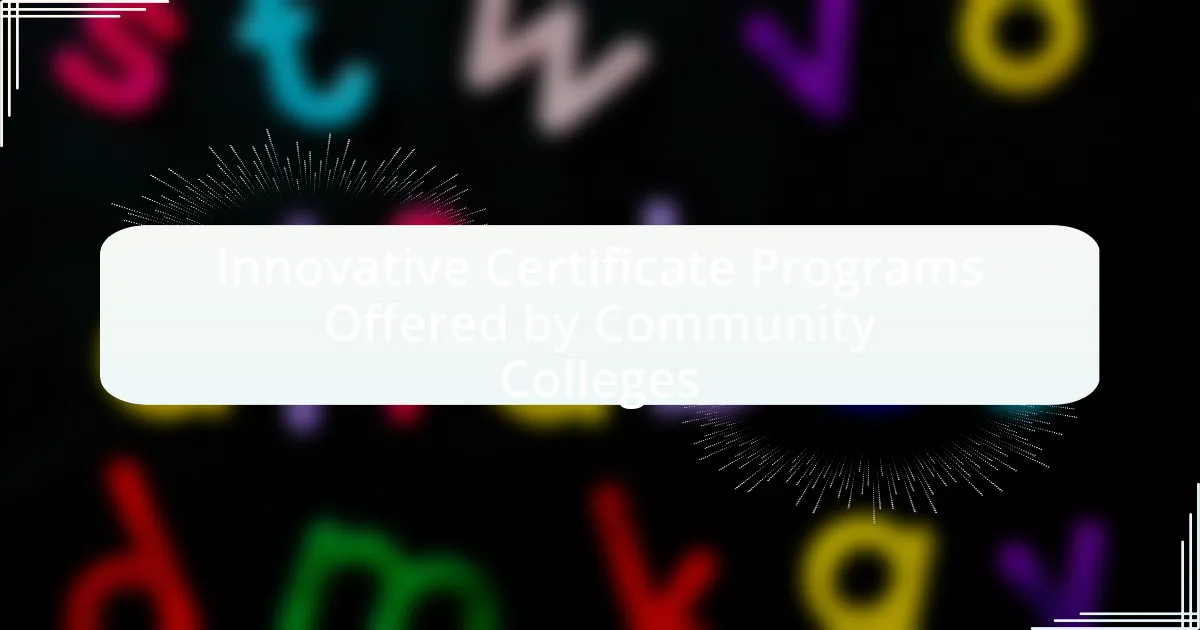Innovative certificate programs offered by community colleges provide specialized training in high-demand fields such as cybersecurity, renewable energy, healthcare, and advanced manufacturing. These programs are designed to meet the evolving job market needs, emphasizing practical skills and hands-on learning experiences. They differ from traditional degree offerings by requiring fewer credits and shorter completion times, making them accessible for adult learners seeking to enhance their employability. Community colleges collaborate with local industries to ensure curricula align with workforce demands, resulting in higher job placement rates for graduates. The growing popularity of these programs is driven by the increasing demand for skilled labor and the flexibility they offer to students.

What are Innovative Certificate Programs Offered by Community Colleges?
Innovative certificate programs offered by community colleges include specialized training in fields such as cybersecurity, renewable energy, healthcare, and advanced manufacturing. These programs are designed to meet the evolving demands of the job market and often feature hands-on learning experiences. For instance, the American Association of Community Colleges reported that many institutions have developed programs in data analytics and artificial intelligence to prepare students for high-demand careers. Additionally, community colleges frequently collaborate with local industries to ensure that their curricula align with current workforce needs, enhancing employability for graduates.
How do these programs differ from traditional degree offerings?
Innovative certificate programs offered by community colleges differ from traditional degree offerings primarily in their duration and focus. These programs typically require fewer credits and can be completed in a shorter time frame, often within a few months to a year, compared to traditional degrees that usually take two to four years. Additionally, certificate programs emphasize practical skills and specific job readiness, aligning closely with workforce demands, whereas traditional degrees often include broader academic coursework. For instance, the U.S. Department of Education reported that certificate holders can enter the job market more quickly, addressing immediate employment needs in various industries.
What unique skills do these certificate programs focus on?
These certificate programs focus on specialized skills tailored to meet industry demands, such as data analytics, cybersecurity, digital marketing, and healthcare management. For instance, data analytics programs equip students with proficiency in statistical analysis and data visualization tools, which are critical in today’s data-driven job market. Similarly, cybersecurity certificates emphasize skills in network security and risk management, addressing the growing need for professionals in this field. These programs are designed to enhance employability by providing practical, hands-on experience aligned with current workforce requirements.
How do community colleges design these innovative programs?
Community colleges design innovative programs by conducting market research to identify workforce needs and collaborating with local industries to ensure alignment with job requirements. This approach allows them to create curricula that are relevant and responsive to the evolving demands of the job market. For instance, many community colleges utilize advisory boards composed of industry professionals to provide insights and feedback on program development, ensuring that the skills taught are in high demand. Additionally, they often incorporate flexible learning options, such as online courses and accelerated formats, to accommodate diverse student populations and learning preferences. This strategic design process is supported by data showing that community colleges that engage with employers and adapt their programs accordingly see higher job placement rates for graduates.
Why are innovative certificate programs gaining popularity?
Innovative certificate programs are gaining popularity due to their ability to provide targeted skills training that meets the demands of the evolving job market. These programs are designed to be flexible and accessible, allowing individuals to quickly acquire relevant competencies in high-demand fields such as technology, healthcare, and skilled trades. According to a report by the American Association of Community Colleges, 70% of employers prefer candidates with specific skills over traditional degrees, highlighting the effectiveness of these certificate programs in aligning education with workforce needs.
What trends in the job market are driving this popularity?
The trends driving the popularity of innovative certificate programs offered by community colleges include the increasing demand for skilled labor in specific industries and the rapid evolution of technology. As industries such as healthcare, information technology, and renewable energy expand, employers seek candidates with specialized skills that traditional degree programs may not provide. According to the U.S. Bureau of Labor Statistics, many of the fastest-growing occupations require postsecondary education but not necessarily a four-year degree, highlighting the value of targeted certificate programs. Additionally, the flexibility and affordability of these programs make them attractive to adult learners and those looking to reskill or upskill in a competitive job market.
How do these programs meet the needs of adult learners?
Innovative certificate programs offered by community colleges meet the needs of adult learners by providing flexible scheduling, relevant curriculum, and practical skills training. These programs often feature evening and weekend classes, allowing adults to balance education with work and family commitments. Additionally, the curriculum is designed to align with current job market demands, ensuring that learners acquire skills that are directly applicable to their careers. For instance, according to the American Association of Community Colleges, 70% of community college students are enrolled part-time, highlighting the importance of flexible learning options. Furthermore, many programs incorporate hands-on training and partnerships with local businesses, which enhances employability and addresses the specific needs of adult learners seeking career advancement.

What types of innovative certificate programs are available?
Innovative certificate programs available at community colleges include programs in data analytics, cybersecurity, renewable energy, and healthcare informatics. These programs are designed to meet the evolving demands of the job market and provide students with practical skills. For instance, the U.S. Bureau of Labor Statistics projects a 31% growth in employment for information security analysts from 2019 to 2029, highlighting the increasing need for cybersecurity training. Additionally, programs in renewable energy focus on sustainable practices, aligning with global initiatives for environmental conservation.
How do industry-specific programs cater to local job markets?
Industry-specific programs cater to local job markets by aligning educational offerings with the specific skills and knowledge required by employers in the region. These programs are developed through collaboration between community colleges and local businesses, ensuring that the curriculum addresses current industry demands. For instance, a community college may partner with technology firms to create a certificate program focused on cybersecurity, directly responding to the growing need for skilled professionals in that field. This targeted approach not only enhances employability for graduates but also supports local economic development by providing businesses with a skilled workforce tailored to their needs.
What examples exist of successful industry partnerships?
Successful industry partnerships include the collaboration between community colleges and local businesses to develop tailored training programs. For instance, the partnership between the City College of San Francisco and local tech companies has resulted in a certificate program in web development that aligns with industry needs, leading to a 90% job placement rate for graduates. Another example is the partnership between Northern Virginia Community College and Amazon, which created a cloud computing certificate program, directly addressing the skills gap in the tech workforce. These partnerships demonstrate the effectiveness of aligning educational programs with industry requirements, resulting in enhanced employability for students and a skilled workforce for employers.
How do these partnerships enhance program relevance?
Partnerships enhance program relevance by aligning educational offerings with industry needs. These collaborations ensure that curriculum development reflects current job market demands, equipping students with skills that employers seek. For instance, community colleges often partner with local businesses to create certificate programs tailored to specific workforce requirements, resulting in higher employment rates for graduates. Data from the American Association of Community Colleges indicates that 70% of community college students find employment in their field of study within six months of graduation, demonstrating the effectiveness of these partnerships in enhancing program relevance.
What are the benefits of enrolling in these certificate programs?
Enrolling in certificate programs offered by community colleges provides several benefits, including enhanced employability, skill development, and cost-effectiveness. These programs are designed to equip students with specific skills that are in demand in the job market, leading to increased job opportunities. According to the U.S. Bureau of Labor Statistics, individuals with postsecondary certificates earn, on average, 20% more than those with only a high school diploma. Additionally, community colleges often offer these programs at a lower cost compared to traditional four-year institutions, making education more accessible. This combination of practical skills training and affordability makes certificate programs a valuable option for career advancement.
How do these programs improve employability for graduates?
Innovative certificate programs offered by community colleges improve employability for graduates by equipping them with industry-relevant skills and practical experience. These programs are designed in collaboration with local employers, ensuring that the curriculum aligns with current job market demands. For instance, a study by the Community College Research Center found that graduates of such programs experience a 20% higher employment rate compared to those without similar credentials. Additionally, hands-on training and internships provided through these programs enhance graduates’ job readiness, making them more attractive to potential employers.
What financial aid options are available for students?
Students have access to various financial aid options, including federal grants, state grants, scholarships, work-study programs, and student loans. Federal grants, such as the Pell Grant, provide need-based financial assistance that does not require repayment, while state grants often support residents attending local institutions. Scholarships, which can be merit-based or need-based, are awarded by colleges, private organizations, and foundations, offering funds that do not need to be repaid. Work-study programs allow students to earn money through part-time employment while enrolled in school. Additionally, federal and private student loans provide funds that must be repaid with interest, helping cover tuition and other educational expenses. According to the National Center for Education Statistics, approximately 85% of undergraduate students receive some form of financial aid, highlighting the importance and availability of these options.

How can students choose the right innovative certificate program?
Students can choose the right innovative certificate program by assessing their career goals, researching program offerings, and evaluating the reputation of the institution. First, students should clearly define their career objectives to ensure alignment with the skills and knowledge provided by the certificate program. Next, they should explore various community colleges that offer innovative programs, focusing on those that provide hands-on experience and industry-relevant training. Additionally, students should consider the institution’s accreditation status and reviews from alumni, as these factors can indicate the quality and effectiveness of the program. According to the American Association of Community Colleges, community colleges play a crucial role in workforce development, offering programs that are tailored to meet local industry needs, which further supports the importance of choosing a program that aligns with both personal and market demands.
What factors should students consider when selecting a program?
Students should consider program relevance, accreditation, cost, duration, and job placement rates when selecting a program. Relevance ensures that the program aligns with their career goals and industry demands. Accreditation confirms that the program meets educational standards, which can affect transferability of credits and job prospects. Cost is crucial as it impacts financial planning and potential student debt; according to the College Board, the average annual tuition for community colleges is significantly lower than that of four-year institutions. Duration affects how quickly students can enter the workforce; many certificate programs can be completed in a year or less. Finally, job placement rates provide insight into the program’s effectiveness in preparing students for employment, with higher rates indicating better outcomes for graduates.
How can students assess the quality of a program?
Students can assess the quality of a program by evaluating its curriculum, faculty qualifications, student outcomes, and accreditation status. A well-structured curriculum should align with industry standards and provide relevant skills. Faculty qualifications, including education and professional experience, are crucial indicators of program quality. Additionally, analyzing student outcomes, such as graduation rates and job placement statistics, offers insights into the program’s effectiveness. Accreditation from recognized bodies further validates the program’s quality, ensuring it meets established educational standards.
What resources are available for researching community college programs?
Resources available for researching community college programs include official college websites, state education department resources, and online databases such as the National Center for Education Statistics (NCES). Official college websites provide detailed information about specific programs, admission requirements, and course offerings. State education departments often publish reports and data on community colleges, including program effectiveness and enrollment statistics. The NCES offers a comprehensive database that allows users to compare community colleges based on various metrics, such as graduation rates and program availability. These resources collectively facilitate informed decision-making for prospective students exploring innovative certificate programs.
What are some best practices for succeeding in these programs?
To succeed in innovative certificate programs offered by community colleges, students should actively engage with course materials and participate in hands-on learning opportunities. Engaging with course materials enhances understanding and retention, while hands-on experiences allow students to apply theoretical knowledge in practical settings. Research indicates that active learning strategies can improve student performance and satisfaction, as evidenced by a study published in the Journal of Educational Psychology, which found that students who participated in interactive learning environments scored significantly higher on assessments compared to those in traditional lecture-based settings. Additionally, networking with instructors and peers can provide valuable support and resources, further contributing to success in these programs.
How can students effectively manage their time while studying?
Students can effectively manage their time while studying by implementing structured planning techniques, such as creating a study schedule and prioritizing tasks. Research indicates that students who use time management strategies, like the Pomodoro Technique, which involves studying for 25 minutes followed by a 5-minute break, report increased focus and productivity. Additionally, a study published in the Journal of Educational Psychology found that students who set specific goals and deadlines for their study sessions are more likely to complete their tasks efficiently. By utilizing these methods, students can enhance their study habits and achieve better academic outcomes.
What strategies can enhance learning and retention of material?
Active learning strategies, such as retrieval practice and spaced repetition, significantly enhance learning and retention of material. Retrieval practice involves actively recalling information, which strengthens memory pathways, while spaced repetition optimizes review timing to combat forgetting. Research by Roediger and Butler (2011) in “The Critical Role of Retrieval Practice in Long-Term Retention” demonstrates that students who engage in retrieval practice outperform those who study passively. Additionally, incorporating varied instructional methods, such as collaborative learning and multimedia resources, can further improve engagement and retention, as supported by studies indicating that diverse approaches cater to different learning styles and increase information retention.

Leave a Reply